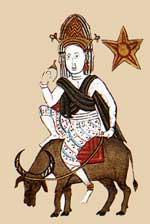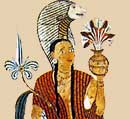The reign of king Dharma Parakramabahu is notable for the arrival of Portuguese. The Portuguese first approached the king for permission to establish a trading centre in Colombo, but later they built a fort and extended their possessions in the country.
During the reign of Buwanekabahu VII they managed to exercise an influence upon the king on the pretext of helping him against his rivals in Kandy and Sitavaka, the other sub-kingdoms that existed at that time. Later they contrived to murder the king and crown his favourite grandson who was only a small boy then and rule the realm as they wished. So, one day in 1551, the aged king was shot in the head at his visit to Kelaniya, and killed by a Portuguese soldier when was resting in the summer house on the lower bank of the river.
Upon his death as was planned Dharmapala, the boy prince succeeded the throne and was acclaimed as Don Juan Dharmapala of Kotte. He was a Christian convert, converted through the contrivance of the Portuguese. This was the beginning of the dark age of Kelani Viharaya as well as the country.

Dharmapala owed his crown to the Portuguese. They, in their turn, exercised an influence upon him and persuaded him to donate all the temple lands within the region to the Portuguese monks to establish Christian institutions. So, by a deed signed in Colombo, he gifted the Kelaniya, North and South of the river, the lands and income to the Roman Catholic Church. Soon Christian churches and other affiliated institutions came up in the close vicinity of the temple, built with the income of its lands.
The Portuguese used this opportunity to accomplish their aim of suppressing Buddhism and propagating their Christian faith. In 1567, at a religious function held in Goa, a decision was taken to destroy Buddhist places of worship in Sri Lanka. The King of Portugal issued orders to this effect.
In 1575, the Portuguese captain Diego de Mello, after defeating a battalion of Sinhala troops at Wattala proceeded to Kelaniya. Here he ordered his troops to loot the temple and then destroy it. So, acting on that order the Portuguese demolished the temple and razed it to the ground.
The Dutch who arrived in the island next conquered the Portuguese in 1640 A.D. They were more bent on suppressing Buddhism and propagating their Christian faith rather than destroying the temples. In 1682, at the instigation of the Christian clergy, they issued a decree prohibiting even the worship of the place where the Kelani Chetiya once stood.
In 1689 A.D. Wimaladharma Suriya, the king of Kandy wished to rebuild the Kelaniya Temple, but the Christian clergy objected and the Dutch refused permission. Two other attempts made in 1699 and 1750 too, was foiled by the Dutch clergy. However, in the year 1780, another request was made by the then Kandyan King, Kirthi Sri Rajasinghe. The Dutch, in their anxiety to please the king, granted his request this time. So Venerable Dehigaspe Attadassi a pupil of Velivita Saranankara Sangho Raja of Kandy, took residence at Kelaniya and carried out restoration work. In a short time the Pagoda, the viharage, the devala and the aramya were rebuilt. Pleased with the work, the king granted a copper sannasa decreeing the incumbency of the temple to Ven. Attadassi and making additional grants of land for its maintenance. Later Ven. Attadassi, in his turn, handed the incumbency to his pupil Ven. Mapitigama Buddharakkita. Since then the incumbency of the temple changed hands from one monk to the other of the Mapitigama papillary succession.
